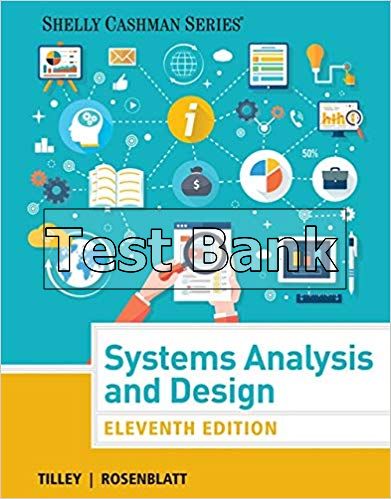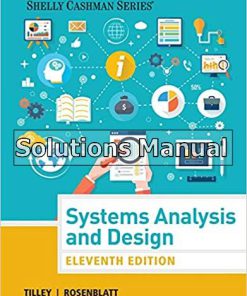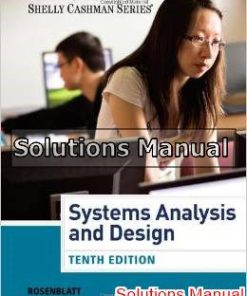Systems Analysis and Design 11th Edition Tilley Test Bank
You may also like
Systems Analysis and Design 11th Edition Tilley Test Bank

Product details:
- ISBN-10 : 1305494601
- ISBN-13 : 978-1305494602
- Author: Scott Tilley
Discover a practical, streamlined, updated approach to information systems development that covers both traditional and emerging technologies and approaches to systems analysis and design. SYSTEMS ANALYSIS AND DESIGN, 11E offers a well-organized, streamlined approach. Chapter objectives are keyed directly to chapter headings, making content easy to comprehend and convenient to study. Numerous real-world examples and screenshots ensure content is current and relevant. In addition, key terms at the end of the chapter now include definitions so you don�t have to flip back and forth to a glossary. Exercises throughout this edition emphasize critical thinking and IT skills in a dynamic, business-related environment. This new edition offers everything you need to prepare for success in today’s intensely competitive and rapidly changing business world.
Table contents:
- Phase 1: Systems Planning
- Ch 1: Introduction to Systems Analysis and Design
- Learning Objectives
- 1.1: Introduction
- 1.2: What is Information Technology?
- 1.3: Information System Components
- 1.4: Business Today
- 1.5: Modeling Business Operations
- 1.6: Business Information Systems
- 1.7: What Information Do Users Need?
- 1.8: Systems Development Tools
- 1.9: Systems Development Methods
- 1.10: The Information Technology Department
- 1.11: The Systems Analyst
- 1.12: Trends in Information Technology
- 1.13: Chapter Summary
- Key Terms
- Chapter Exercises
- Ch 2: Analyzing the Business Case
- Learning Objectives
- 2.1: Introduction
- 2.2: A Framework for IT Systems Development
- 2.3: What is a Business Case?
- 2.4: Information Systems Projects
- 2.5: Evaluation of Systems Requirements
- 2.6: Overview of Feasibility
- 2.7: Evaluating Feasibility
- 2.8: Setting Priorities
- 2.9: Preliminary Investigation Overview
- 2.10: Chapter Summary
- Key Terms
- Chapter Exercises
- Ch 3: Managing Systems Projects
- Learning Objectives
- 3.1: Introduction
- 3.2: Overview of Project Management
- 3.3: Creating a Work Breakdown Structure
- 3.4: Identifying Task Patterns
- 3.5: Calculating the Critical Path
- 3.6: Project Monitoring and Control
- 3.7: Reporting
- 3.8: Project Management Examples
- 3.9: Project Management Software
- 3.10: Risk Management
- 3.11: Managing for Success
- 3.12: The Bottom Line
- 3.13: Chapter Summary
- Key Terms
- Chapter Exercises
- Phase 2: Systems Analysis
- Ch 4: Requirements Modeling
- Learning Objectives
- 4.1: Introduction
- 4.2: Systems Analysis Phase Overview
- 4.3: Joint Application Development
- 4.4: Rapid Application Development
- 4.5: Agile Methods
- 4.6: Modeling Tools and Techniques
- 4.7: System Requirements Checklist
- 4.8: Future Growth, Costs, and Benefits
- 4.9: Fact-Finding
- 4.10: Interviews
- 4.11: Other Fact-Finding Techniques
- 4.12: Documentation
- 4.13: Information Management Software
- 4.14: Preview of Logical Modeling
- 4.15: Chapter Summary
- Key Terms
- Chapter Exercises
- Ch 5: Data and Process Modeling
- Learning Objectives
- 5.1: Introduction
- 5.2: Overview of Data and Process Modeling Tools
- 5.3: Data Flow Diagrams
- 5.4: Creating a Set of DFDs
- 5.5: Guidelines for Drawing DFDs
- 5.6: Data Dictionary
- 5.7: Process Description Tools
- 5.8: Logical versus Physical Models
- 5.9: Chapter Summary
- Key Terms
- Chapter Exercises
- Ch 6: Object Modeling
- Learning Objectives
- 6.1: Introduction
- 6.2: Overview of Object-Oriented Analysis
- 6.3: Relationships among Objects and Classes
- 6.4: Object Modeling with the Unified Modeling Language
- 6.5: Organizing the Object Model
- 6.6: Chapter Summary
- Key Terms
- Chapter Exercises
- Ch 7: Development Strategies
- Learning Objectives
- 7.1: Introduction
- 7.2: Development Strategies Overview
- 7.3: The Impact of the Internet
- 7.4: Outsourcing
- 7.5: In-House Software Development Options
- 7.6: The Systems Analyst’s Role
- 7.7: Analyzing Cost and Benefits
- 7.8: The Software Acquisition Process
- 7.9: Completion of Systems Analysis Tasks
- 7.10: Transition to Systems Design
- 7.11: Chapter Summary
- Key Terms
- Chapter Exercises
- Phase 3: Systems Design
- Ch 8: User Interface Design
- Learning Objectives
- 8.1: Introduction
- 8.2: Systems Design Phase Overview
- 8.3: Chapter Overview
- 8.4: What is a User Interface?
- 8.5: Seven Habits of Successful Interface Designers
- 8.6: Guidelines for User Interface Design
- 8.7: Source Document and Form Design
- 8.8: Printed Output
- 8.9: Technology Issues
- 8.10: Security and Control Issues
- 8.11: Where Do We Go from Here?
- 8.12: Chapter Summary
- Key Terms
- Chapter Exercises
- Ch 9: Data Design
- Learning Objectives
- 9.1: Introduction
- 9.2: Data Design Concepts
- 9.3: DBMS Components
- 9.4: Web-Based Design
- 9.5: Data Design Terms
- 9.6: Entity-Relationship Diagrams
- 9.7: Data Normalization
- 9.8: Two Real-World Examples
- 9.9: Using Codes
- 9.10: Data Storage and Access
- 9.11: Data Control
- 9.12: Chapter Summary
- Key Terms
- Chapter Exercises
- Ch 10: System Architecture
- Learning Objectives
- 10.1: Introduction
- 10.2: Architecture Checklist
- 10.3: System Architecture: Then and Now
- 10.4: Client/Server Designs
- 10.5: The Impact of the Internet
- 10.6: Ecommerce Architecture
- 10.7: Processing Methods
- 10.8: Network Models
- 10.9: Wireless Networks
- 10.10: Systems Design Completion
- 10.11: Chapter Summary
- Key Terms
- Chapter Exercises
- Phase 4: Systems Implementation
- Ch 11: Managing Systems Implementation
- Learning Objectives
- 11.1: Introduction
- 11.2: Software Quality Assurance
- 11.3: Overview of Application Development
- 11.4: Structured Application Development
- 11.5: Object-Oriented Application Development
- 11.6: Agile Application Development
- 11.7: Coding
- 11.8: Testing the System
- 11.9: Documentation
- 11.10: Management Approval
- 11.11: System Installation and Evaluation
- 11.12: Operational and Test Environments
- 11.13: Training
- 11.14: Data Conversion
- 11.15: System Changeover
- 11.16: Post-Implementation Tasks
- 11.17: Chapter Summary
- Key Terms
- Chapter Exercises
- Phase 5: Systems Support and Security
- Ch 12: Managing Systems Support and Security
- Learning Objectives
- 12.1: Introduction
- 12.2: User Support
- 12.3: Maintenance Tasks
- 12.4: Maintenance Management
- 12.5: System Performance Management
- 12.6: System Security Overview
- 12.7: Security Levels
- 12.8: Backup and Recovery
- 12.9: System Obsolescence
- 12.10: Future Challenges and Opportunities
- 12.11: Chapter Summary
- Key Terms
- Chapter Exercises
- The Systems Analyst’s Toolkit
- Part A: Communication Tools
- Learning Objectives
- A.1: Introduction
- A.2: Successful Communication Strategies
- A.3: Written Communications
- A.4: Oral Communications
- A.5: Managing Your Communication Skills
- A.6: Toolkit Summary
- Key Terms
- Toolkit Exercises
- Part B: CASE Tools
- Learning Objectives
- B.1: Introduction
- B.2: Overview of CASE Tools
- B.3: CASE Terms and Concepts
- B.4: Development Environments
- B.5: CASE Tool Trends
- B.6: Toolkit Summary
- Key Terms
- Toolkit Exercises
- Part C: Financial Analysis Tools
- Learning Objectives
- C.1: Introduction
- C.2: Describing Costs and Benefits
- C.3: Cost-Benefit Analysis
- C.4: Toolkit Summary
- Key Terms
- Toolkit Exercises
- Part D: Internet Resource Tools
- Learning Objectives
- D.1: Introduction
- D.2: Planning an Internet Research Strategy
- D.3: Search Basics
- D.4: Search Engines
- D.5: Subject Directories
- D.6: The Invisible Web
- D.7: Internet Communication Channels
- D.8: Information Technology Community Resources
- D.9: Toolkit Summary
- Key Terms
- Toolkit Exercises
- Glossary
- Index
People also search:
systems analysis and design 11th edition tilley solutions manual
what is system design in system analysis and design
what is the purpose of systems analysis and design
what is system analysis and design
system analysis and design difference












